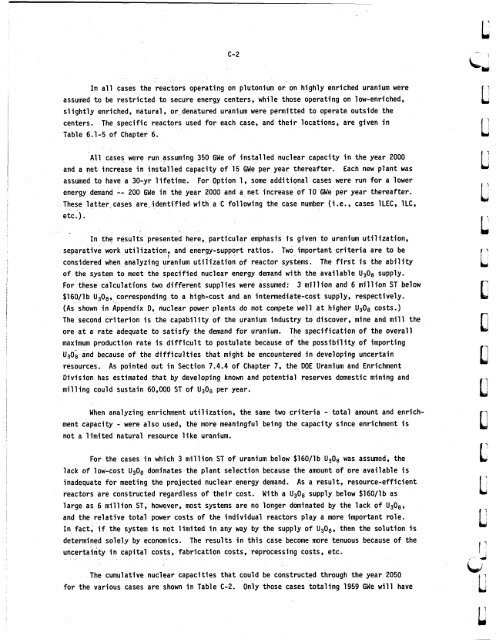ORNL-5388 - the Molten Salt Energy Technologies Web Site
ORNL-5388 - the Molten Salt Energy Technologies Web Site
ORNL-5388 - the Molten Salt Energy Technologies Web Site
Create successful ePaper yourself
Turn your PDF publications into a flip-book with our unique Google optimized e-Paper software.
c-2<br />
In all cases <strong>the</strong> reactors operating on plutonium or on highly enriched uranium were<br />
assumed to be restricted to secure energy centers, while those operating on low-enriched,<br />
slightly enriched, natural, or denatured uranium were permitted to operate outside <strong>the</strong><br />
centers. The specific reactors used for each case, and <strong>the</strong>ir locations, are given in<br />
Table 6.1-5 of Chapter 6.<br />
All cases were run assuming 350 GWe of installed nuclear capacity in <strong>the</strong> year 2000<br />
and a net increase in installed capacity of 15 GWe per year <strong>the</strong>reafter. Each new plant was<br />
assumed to have a 30-yr lifetime. For Option 1, some additional cases were run for a lower<br />
energy demand -- 200 GWe in <strong>the</strong> year 2000 and a net increase of 10 GWe per year <strong>the</strong>reafter.<br />
These latter,cases are-identified with a C following <strong>the</strong> case number (i.e., cases lLEC, lLC,<br />
etc.).<br />
In <strong>the</strong> results presented here, particular emphasis is given to uranium utilization,<br />
separative work utilization, and energy-support ratios. Two important criteria are to be<br />
considered when analyzing uranium utilization of reactor systems.<br />
of <strong>the</strong> system to meet <strong>the</strong> specified nuclear energy demand with <strong>the</strong> available U308 supply.<br />
For <strong>the</strong>se calculations two different supplies were assumed:<br />
$160/1 b U308, corresponding to a high-cost and an intermediate-cost supply, respectively.<br />
(As shown in Appendix D, nuclear power plants do not compete well at higher U308 costs.)<br />
The second criterion is <strong>the</strong> capability of <strong>the</strong> uranium industry to discover, mine and mill <strong>the</strong><br />
ore at a rate adequate to satisfy <strong>the</strong> demand for uranium.<br />
maximum production rate is difficult to postulate because of <strong>the</strong> possibility of importing<br />
U3Oi and because of <strong>the</strong> difficulties that might be encountered in developing uncertain<br />
resources. As pointed out in Section 7.4.4 of Chapter 7, <strong>the</strong> DOE Uranium and Enrichment<br />
Division has estimated that by developing known and potential reserves domestic mining and<br />
milling could sustain 60,000 ST of U30s per year.<br />
The first is <strong>the</strong> ability<br />
3 million and 6 million ST below<br />
The specification of <strong>the</strong> overall<br />
When analyzing enrichment utilization, <strong>the</strong> same two criteria - total amount and enrich-<br />
ment capacity - were also used, <strong>the</strong> more meaningful being <strong>the</strong> capacity since enrichment is<br />
not a limited natural resource like uranium.<br />
For <strong>the</strong> cases in which 3 million ST of uranium below $160/lb U308 was assumed, <strong>the</strong><br />
lack of low-cost U308 dominates <strong>the</strong> plant selection because <strong>the</strong> amount of ore available is<br />
inadequate for meeting <strong>the</strong> projected nuclear energy demand. As a result, resource-efficient<br />
reactors are constructed regardless of <strong>the</strong>ir cost. With a U308 supply below $160/lb as<br />
large as 6 million ST, however, most systems are no longer dominated by <strong>the</strong> lack of U308,<br />
and <strong>the</strong> relative total power costs of <strong>the</strong> individual reactors play a more important role.<br />
In fact, if <strong>the</strong> system is not limited in any way by <strong>the</strong> supply of U308, <strong>the</strong>n <strong>the</strong> solution is<br />
determined solely by economics. The results in this case become more tenuous because of <strong>the</strong><br />
uncertainty in capital costs, fabrication costs, reprocessing costs, etc.<br />
The cumulative nuclear capacities that could be constructed through <strong>the</strong> year 2050<br />
for <strong>the</strong> various cases are shown in Table C-2. Only those cases totaling 1959 GWe will have<br />
c<br />
I]<br />
c<br />
L<br />
L<br />
c<br />
1:<br />
c<br />
c<br />
L<br />
. d<br />
LJ<br />
L



![Review of Molten Salt Reactor Physics Calculations [Disc 2]](https://img.yumpu.com/21979492/1/190x247/review-of-molten-salt-reactor-physics-calculations-disc-2.jpg?quality=85)












